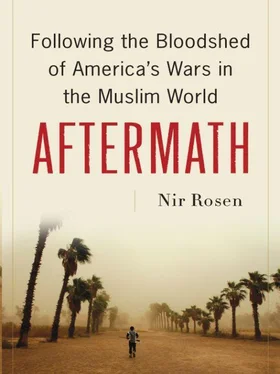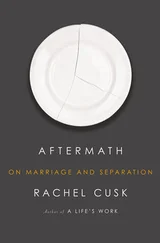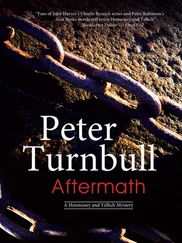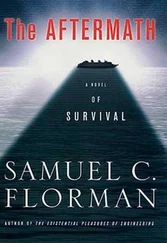The Saudis were getting nervous, watching their proxies throughout the region weaken. In the 1960s Egypt’s pan-Arab nationalist Gamal Abdel Nasser was the main competition with Saudi influence in the region. The Saudis and Americans both tried to undermine Arab nationalist and leftist movements. The result was an increase in the power of fundamentalists and the weakening of Arab progressives. The Saudis now had no Arab rivals for their influence with the less powerful exceptions of Qatar and Syria. But Hizballah (and Hamas in Palestine) represented resistance to the Saudi, Israeli, and American project in the region, and the Saudis would not tolerate it.
ON AUGUST 10, 2007, four days before Hizballah was to commemorate the “divine victory” over Israel (as they called it), I visited the Salam Mosque in Tripoli, a northern coastal city—Lebanon’s second-largest—and its Sunni bastion. Hundreds of men filled the mosque and overflowed onto straw mats outside. They sat in the heat listening to a fiery sermon with apparent indifference. Sheikh Bilal Barudi, a Sunni cleric close to the March 14 coalition and also part of the Independent Islamic Gathering of Sunni clerics, gave the sermon. Arabs were once again in conflict with the Persians, he said, a conflict he saw as age-old and also between Sunnis and Shiites. “We ask the Iranians and Americans to withdraw from Iraq,” he said. “Iran is our historic enemy. Throughout history Iran always had an ambition of controlling Arab countries around them.” He spoke of the Shiites of Lebanon occupying Beirut, mocking Hizballah’s “divine victory” and calling its members enemies of Islam. The war had started after Hizballah captured two Israeli soldiers, hoping to exchange them for four leftist Lebanese resistance fighters held by the Israelis. Barudi condemned Hizballah for destroying Lebanon to rescue leftists whom he called “infidels.” This was a refrain I would hear repeatedly over the next year.
One of those attending the prayer that Friday was Samir Jisr, a member of Parliament with the Future Movement, the Saudi-backed political movement clustered around Saad al-Hariri, which he inherited from his father, Rafiq. I met Jisr in his home a few blocks away. He explained to me that just as Sunnis had felt threatened during the Syrian era, so now they felt threatened by Hizballah. “Most people here were with the resistance to Israel,” he said. “People looked at Hizballah as the resistance, but after the Israelis withdrew and they practiced politics and shifted to inside Lebanon, people considered it a threat.” He explained that it was the presence of pro-Hizballah demonstrators “in the heart of the streets . . . the way they threaten to stop the country,” and their possession of weapons, that “scares people.” Jisr had criticized the army publicly for allegedly torturing Lebanese Sunnis suspected of militancy. Now Sunni militants were afraid, he said.
He blamed poverty and oppression for increasing extremism and complained that after the civil war Beirut had gotten all the attention in the reconstruction while the north was neglected. The Syrians were hated, he said, because of their shelling of Tripoli in the 1980s, which he claimed killed up to 1,200 Sunnis. “It’s a big wound for people in Tripoli,” he said. The war in Iraq had negative effects on Lebanon too: “They are not spreading democracy. It’s obvious that they are trying to divide Iraq and steal its resources. Everybody believes the Americans are responsible for Sunni-Shiite problems. There is a fear among people that what is happening in Iraq will affect Lebanon.”
Dai al-Islam al-Shahal, Lebanon’s most important Salafi cleric, blamed Shiites and Iran for the civil war in Iraq. Many Salafi clerics like him were obsessed with Shiites; Shahal was rabidly anti-Shiite. “The Sunnis in Iraq are oppressed by Shiites, and Iranians are allying with Americans there,” he told me.
I met Shahal in his office in Tripoli’s Abu Samra neighborhood, where many Salafis are based. It was August 14, or “Victory Day,” according to Hizballah. As I waited for Shahal to arrive in the morning, his devoted young male secretary assured me that my heart would race when I saw him. Shahal had a white beard and wore a white robe, with a white cap and a white scarf on his head.
Like most Sunnis, he did not think that the war with Israel had, in fact, ended with a victory—he wished it had not happened. He viewed Hizballah as a threat to the Lebanese government and the entire country. “There is an old Shiite project to control Lebanon,” he told me, mentioning the canard of the “Shiite crescent,” first described by Jordan’s King Abdullah. “Iran is exporting its Islamic Revolution,” he said, and “the project of controlling Lebanon is being implemented. A minority rules Syria, allied with Shiites here and Iranians in Iraq.”
Although Sunnis were being targeted, “Sunnis are more powerful,” he told me. “If, God forbid, a civil war happens, they know how to defend themselves and are prepared.” Sunnis were engaged with the state, he explained, but in the event of a civil war they would require militias. And while Sunnis in the government were allying with the Americans, “people on the street are totally against the Americans.” Sunni Islamists had allied with the Future Movement and the Lebanese government because they defended Sunnis, he explained, but relations between Sunnis and the government had been damaged by the fighting in Nahr al-Barid.
Shahal had been one of the key negotiators between Lebanese authorities and Fatah al-Islam. “Fatah al-Islam used Fatah al-Intifada as a passage into Lebanon to set up a movement to fight Israel,” he said. “Most of Fatah al-Islam are not Palestinian.” Fatah al-Islam’s ideology had been close to that of Al Qaeda, he said. Muslims were under attack, he said, explaining that the American administration wanted to strike Islam and was trying to establish bases in Muslim lands to take their resources. “The defense of Muslim lands from America and the West is better than attacking Americans and the West in their countries,” he said. Al Qaeda’s mistake was “moving the battle to Western territory. When Muslims are under attack, it is right to defend themselves but not to move the battle to the West.”
IF THERE IS A RED LINE separating Sunnis from Shiites in Beirut, it is the Tariq al-Jadida neighborhood, a Sunni bastion close to Dahiyeh, the southern Shiite suburb dominated by Hizballah. Entering the neighborhood, one passes a Saudi flag, a Lebanese flag, and the flag of the Future Movement. Large posters of Saudi King Abdullah hang above the streets. Beginning in early 2007 various local militias began to appear, their names changing often. One was called the Panthers. Every night the streets of Tariq al-Jadida were patrolled by men who did not carry arms in public. They were recruited and paid by the Future Movement. Typically they were young men sitting on street corners, smoking water pipes, eating pistachios, and demanding that passersby present their identification papers. Sometimes they had lists of wanted men. They were supervised by older men, veterans of the Lebanese army, security forces, or militias from the civil war. Just in case, Interior Security Forces sat in armored personnel carriers in the center of the neighborhood. On my first visit, in 2007, I asked some of the young men who they were protecting the neighborhood from. “ Zaaran ,” said one muscular youth, referring to hoodlums, or thugs. I asked which zaaran . “From Dahiyeh,” he said. “We will chop them up.” During this visit, I was stopped by chubby young men on scooters who zipped over and took me to what they called on their radios Checkpoint One. Fortunately I had befriended a local militiaman named Fadi, a small man who owned a barbershop close to the edge of the neighborhood, who vouched for me. Fadi had a ponytail, wore tight black clothes, and had a huge shiny watch on his wrist. He patrolled his street on behalf of the local Future militia and was paid four hundred dollars a month by the Secure Plus company, which he said was the same as the Future Movement. Fadi had not done his military service, but he had received one month of training in Akkar.
Читать дальше











